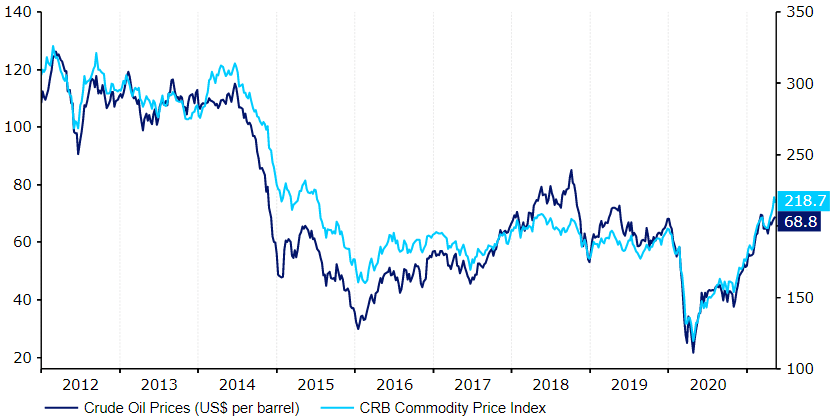How the commodity market could impact FX in 2021

One of the key moves witnessed among asset classes during 2021 thus far has been the sharp increase in commodity prices. But what impact have these moves had on the FX market?
Commodity prices have risen across the board since the start of the year, led by a sharp move higher in global oil prices. Brent crude oil futures have risen by approximately 35% from $52 a barrel to $70, which is roughly where they were prior to the outbreak of the COVID-19 virus at the beginning of 2020. Gains in the price of metals have also been broad based, with many rising to all-time highs. Agricultural prices have also experienced a similarly sharp rally, some more than 50% year-to-date. The CRB Commodity index, which represents an arithmetic average of commodity futures prices, is subsequently now at its highest level since July 2015 (Figure 1).
Figure 1: CRB Commodity Price Index vs. Brent Crude Oil Futures (2012 - 2021)
Source: Refinitiv Datastream Date: 19/05/2021
What factors have driven commodity prices higher?
- Faster-than-expected global economic recovery. The rollout of the various COVID-19 vaccines has taken place at a faster pace than anticipated, even as recently as late-last year. The vaccines have also proved highly effective in both suppressing rates of virus contagion and driving down COVID-related fatalities, allowing a material unwinding of restrictions in the likes of the US and UK. This has raised hopes of a swift global economic recovery among investors, and has caused market participants to price in much higher demand for commodities during the remainder of the year.
- Highly accommodative monetary and fiscal policies. Central banks have slashed interest rates to record lows and government’s around the world have pumped vast amounts of stimulus into their economies in order to support jobs and households during the pandemic period. Policy is likely to remain highly accommodative for some time yet - the Federal Reserve, for instance, is not expecting to raise rates until 2024. Interest rates and commodity prices have an historical inverse relationship. A low-interest rate environment not only supports consumer demand, but also lowers the cost of carry - the physical cost of storing commodities over a period of time. When the cost of carry is low, commodities tend to rise in price.
- Low prices since the 2014/5 commodity crash have discouraged exploration and development. Inadequate supply to meet growing demand creates an unhealthy cocktail whereby prices can spiral higher over a prolonged period of time, known as a ‘supercycle’. Fears over a new such cycle have emerged in recent weeks as a number of analysts question whether supply will be sufficient to match booming demand. We think that supply shortages have been slightly overplayed, but could be a factor in driving commodity prices higher in the medium-term.
What impact have we seen in FX so far?
Unsurprisingly, the rebound experienced in commodity prices has been supportive of currencies of countries that are highly dependent on the primary sector. The two best performing major currencies year-to-date have been the Canadian dollar and Norwegian krone, the most commodity-dependent currencies in the G10. Emerging market currencies tend to benefit disproportionately from higher commodity prices, as developing nations generally rely on the production of commodities for a greater share of their GDP than the major nations. The slower vaccination rollout in EM nations has, however, dampened sentiment towards EM currencies - the MSCI emerging market currency index has risen only 1% year-to-date, significantly lagging the move higher in commodities.
Figure 2: G10 FX Performance Tracker (YTD)
Source: Refinitiv Datastream Date: 19/05/2021
How do we expect currencies to react during the remainder of 2021?
We think that there is room for further upside in commodities during the remainder of the year and think that we could see additional gains in prices once virus restrictions are removed to a greater extent. We think that this would be a conducive environment for high-risk currencies, particularly emerging market ones, at the expense of the US dollar. The currencies that could benefit the most from the rally in commodities are likely to be those that:
Have historically had the highest correlation with commodities, notably the Canadian dollar (+0.65*), Norwegian krone (+0.64) and Australian dollar (+0.62).
Are the most undervalued based on a linear regression with commodity indices. By our calculation, this is the Brazilian real (67% undervalued**), Colombian peso (30%) and Russian ruble (25%).
*correlation with Bloomberg Commodity Index (12/05/16 - 12/05/21, monthly)
** based on a linear regression with Bloomberg Commodity Index (12/05/16 - 12/05/21, monthly)
Author

Matthew Ryan, CFA
Ebury
Matthew is Global Head of Market Strategy at FX specialist Ebury, where he has been part of the strategy team since 2014. He provides fundamental FX analysis for a wide range of G10 and emerging market currencies.



















